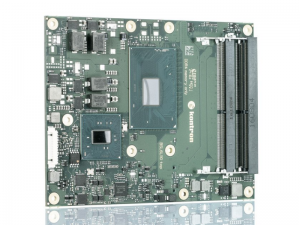Computer-On-Modules
Computer-on-Modules (COM) provide the essential functions of a PC – CPU, graphics processor, main memory, power management and standard interfaces – in a compact, versatile module. This is plugged or soldered onto an application-specific carrier board via one or two connectors. The fact that COM integrates compatible hardware on a module and that drivers and firmware are already available significantly reduces the time and effort required to design customer products. A specified heatspreader, which acts as a thermal interface between the COM and the cooling solution, also makes it much easier to connect the COM to a cooling solution.
Depending on the area of application and requirements, different standards of Computers-On-Modules are available:
- COM-HPC (Computer-On-Module High Performance Computing)
- COM Express (COMe)
- Qseven and µQseven
- SMARC
- System-on-Module (OSM)
They differentiate themselves mainly in terms of size, performance and interfaces. Because computer-on-modules can be exchanged across processor generations thanks to standardization, they also guarantee the longevity, flexibility and independence required for industrial use.
COM-HPC® is a new standard that represents a further development of the proven COM Express® standard for performance-hungry applications. There are three module types: COM-HPC/Client, COM-HPC/Server and COM-HPC/Mini.
- COM-HPC/Client: For high-end embedded client products with displays, versatile I/O, powerful CPU and compact size.
- COM-HPC/Server: For high-end headless embedded servers with high CPU capacity, large memory, many I/O options.
- COM-HPC/Mini (95 mm x 70 mm): More compact format, high-speed connector with 400 pins, supports two 10 GbE interfaces, 16x PCIe lanes up to PCIe Gen5 and 4 USB 4 interfaces.
COM Express® has been the industry standard for more than 15 years. With 3 different form factors (mini, compact, basic), performance classes are available for every application.
Mini (55 x 84 mm) is particularly suitable for mobile applications in the lower performance range (Intel® Atom™ ) with little space;
Compact with a foodprint of 95 x 95 mm is mainly used for higher-performance and power-saving platforms (U-series);
On basic (125 x 95 mm), mobile CPUs with a TDP of up to 47 watts are available (Intel® Core™).
With 70mm x 70mm and the MXM Edge Connector, this industry standard is perfectly well suited for mobile applications with low height.
With 70mm x 40mm, the “little brother” of the Qseven® module is also available. This module is in sub-check card format with the MXM Edge Connector especially suitable for small applications.
The main difference between System-on-Modules (OSM) and standards such as COM, QSeven or SMARC is that the modules are not plugged onto the carrier board but soldered. Otherwise, SoMs also combine CPU, flash and RAM as well as the power supply on a compact PCB.

Low-Power Embedded Architecture Plattform für Computer-on-Modules auf Basis von ARM und X86 Technologie;
Bietet dank der erhöhten Anzahl an Pins (MXM-3 Connector) eine Vielzahl von Schnittstellen;
Ermöglicht mobile, vernetzte Embedded-Lösungen;
Für den Einsatz unter rauen industriellen Umgebungsbedingungen entwickelt.




